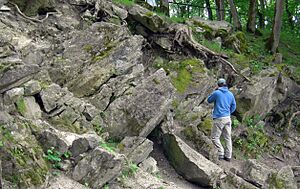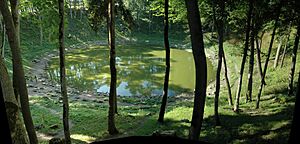Kaali crater facts for kids
| Impact crater/structure | |
|---|---|
| Confidence | Confirmed |
| Diameter | 110 m (360 ft) |
| Age | 3237+/-10 14C yr BP |
| Location | |
| Coordinates | 58°22′22″N 22°40′10″E / 58.37278°N 22.66944°E |
| Country | Estonia |

Kaali is a special place in Estonia, on the island of Saaremaa. It's a group of nine holes in the ground, called craters, made by a meteorite hitting Earth. The biggest crater is known as Kaali Lake. Scientists believe these craters formed around 3,500 years ago, between 1530 and 1450 BC. This was a huge event, especially since it happened in an area where people might have lived. For a long time, people weren't sure how these craters formed. Some thought they were from volcanoes or natural rock changes. But in the 1930s, a scientist named Ivan Reinvald proved they were made by a meteorite.
Contents
How the Kaali Craters Formed
Scientists think the meteorite hit Earth during the Holocene period, about 3,500 years ago. There are different ideas about the exact date, but most agree it was a long time ago. Some studies suggest it could be around 7,600 years old, while others point to a more recent time, like the 4th century BC.
The meteorite was moving very fast, between 10 and 20 kilometers per second. It weighed between 20 and 80 metric tons. Some researchers believe it came from the northeast.
When the meteorite was about 5 to 10 kilometers above the ground, it broke into many pieces. The largest piece created the main crater, which is 110 meters wide and 22 meters deep. The explosion was incredibly powerful. It blasted away about 81,000 cubic meters of rock. It also created a super-hot gas cloud, about 7 to 8 kilometers tall. This intense heat burned all the plants and trees up to 6 kilometers away from the impact site.
Today, Kaali Lake sits at the bottom of this main crater. There are also eight smaller craters nearby. These smaller craters range from 12 to 40 meters wide and 1 to 4 meters deep. All of them are within 1 kilometer of the main crater.
Impact on the Environment
If the impact happened around 3,500 years ago, it would have been during the Nordic Bronze Age. At that time, Estonia was mostly covered in forests, with a small number of people living there. The energy released by the impact was enormous, about 80 terajoules. To give you an idea, this is similar to the energy of the Hiroshima atomic bomb. This massive blast would have set fire to forests within a 6-kilometer area around the impact site.
Kaali in Ancient Stories
Many experts believe that the Kaali impact was a very important event in the local mythology. The lake was, and still is, seen as a sacred lake. There is also evidence that people might have used it for special rituals a long time ago. During the early Iron Age, a stone wall was built around the lake. This wall was about 470 meters long, 2.5 meters wide, and 2 meters tall.
Stories from Finnish mythology might also be connected to the formation of Kaali. For example, in the Kalevala epic, there's a story where the evil wizard Louhi steals the Sun and fire, making everything dark. The sky god Ukko orders a new Sun to be made from a spark. But this spark falls from the sky and lands in a lake, making its water rise. Finnish heroes then go looking for this fire and find it in a forest fire. Some think this story could be about the Kaali impact.
A theory by Lennart Meri suggests that Saaremaa island might be the legendary Thule island, first mentioned by an ancient Greek geographer named Pytheas. The name "Thule" could be linked to the Finnic word tule, which means "(of) fire." This idea connects to the Estonian stories about the fiery birth of the Kaali crater lake. People even believed that Kaali was the place where "The sun went to rest."
Asteroid Named After Kaali
There is an asteroid named 4227 Kaali. However, other than sharing the name, this asteroid has no direct connection to the Kaali crater.
Ancient Iron Arrowhead
In 2023, archaeologists studied an arrowhead found in Switzerland. This arrowhead was made from iron that came from a meteorite. Scientists found that the iron in this arrowhead matched the composition of the Kaali meteorite. This suggests that pieces of the Kaali meteorite might have traveled far and were used by ancient people.





